It’s winter in Maryland. In fact, it’s so much winter I shoveled 10 inches of snow off my driveway this morning. Fortunately, I had company. It wasn’t the kind of company that picks up a shovel and helps out, but still, the American robins darting back and forth over my head were still welcome (if surprising and surprisingly quiet) snow day companions.
Become a Member
Make a lasting impact for nature when you join The Nature Conservancy
“You know,” I said to them as I leaned on my shovel to watch about 25 birds flock together in my neighbor’s oak. “I think y’all are a little early—aren’t you supposed to be the first harbingers of spring?”
We’re not even a month past the first day of winter in the northern hemisphere. Spring is definitely not here. So why are the robins? Shouldn’t they be sunning themselves in warmer climes?
The short answer: as long as there’s food, American robins—true to their name Turdus migratorius (“the wandering thrush”)—kind of spend their winters coming and going as they please.
Robin Migration (AKA Robin Wandering)
Robins do migrate—but they don’t necessarily follow a more or less straight line from north to south in the fall, then repeat the journey south to north in the spring. In the fall and winter, when the ground freezes, robins lose access to their meal of choice: worms, insects (adult and larval) and (occasionally) snails. That’s when they turn to their winter diet staple: mostly fruit, mostly berries.
The folks at Journey North, a project tracking robin movements run by the University of Wisconsin-Madison, put it this way, “Some robins retreat all the way to southern Texas and Florida (in fact, some of the largest winter flocks documented by the Christmas Bird Count gather in sunny St. Petersburg, Florida), but others winter as far north as they can find berries. So they have an enormous winter range. Robins do migrate, but it has more to do with food sources than with being faithful to the same places year over year.”
In that way American robins are somewhat akin to teenage boys—they tend to go where the best (or most abundant or most easily accessible) food is, stay until it’s depleted, and then move on.
So as long as there are enough berries and other fruits to sustain them, you may see robins off and on throughout the winter across much of North America.
Forget the birdseed though. Robins’ digestive systems, unlike sparrows or other so-called feeder birds, aren’t built for dealing with seed, and their beaks aren’t built for cracking things open. Robin beaks are built for snapping up worms, catching insects, and plucking berries and other fruits. In the winter, a flock of robins can strip a holly bush with impressive speed and efficiency, and very little—if any—violent robin-on-robin aggression.
Food is also one of the reasons that robins, notoriously territorial and aggressive in breeding season, tend to gather and travel in flocks in the fall and winter. Numbers are good for defense, and also for spotting food—if one robin happens on a holly tree full of bright, ripe berries, the whole flock can partake. And then move on.
The tendency of robins to flock in winter may also be one of the reasons people seem to notice them—birds in large numbers tend to stand out when they’re gathered in leafless trees. (That and the beautiful red breast that is sometimes the only splash of color in a winter landscape that looks practically lunar in relentless shades of February white and gray.)
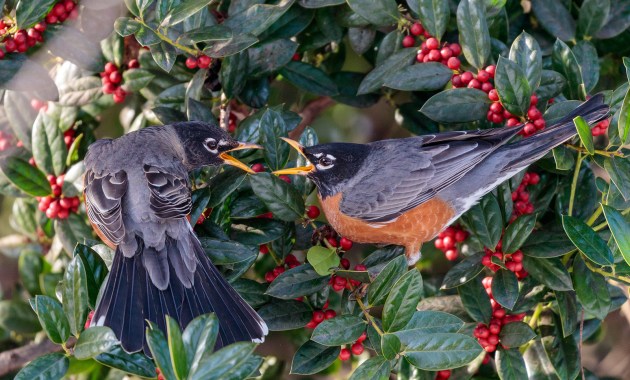
How do Robins Survive the Cold?
Robins are outfitted to survive huge temperature variances. In fact, hot weather seems to stress them more than cold.
If an American robin is healthy, has enough to eat, and is able to main its feathers, the temperature next to its body stays around 104 F—regardless of how cold it is in the world outside. It really is all about those feathers. (And the legs and feet.)
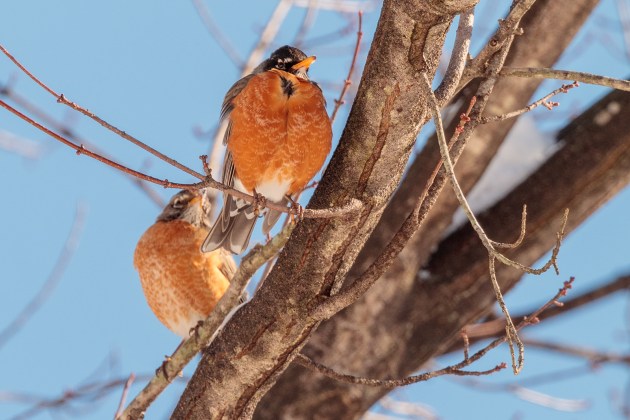
Robins, like most birds, have layers of feathers that perform different functions. When temperatures drop, robins puff the fine, downy feathers closest to their bodies to keep heat in, cold out. The outer feathers act like a kind of overcoat, shedding water and moisture and helping to regulate the bird’s temperature. (It’s an adaptation not limited to robins. Most birds with down feathers fluff them to regulate body heat).
The anatomy of a robin’s (and other bird species) also contributes to their cold adaptations. The bird experts over at the Cornell Lab explain it very well. The simplified version is that “most birds don’t succumb to frostbite because there is so little fluid in the cells of their feet, and their feet are mostly tendons and bones with little muscle or nerve tissue.”
So while blood does flow to their legs and feet, most birds (including robins) benefit from a very fast circulatory system and a “countercurrent heat exchange system.” Because bird legs are thin, the vessels that move blood from the heart to the feet and back again are very close together. That proximity means, per Cornell, “blood flowing back to the body is warmed by blood flowing to the feet. The newly cooled blood in the feet lowers heat loss from the feet, and the warmed blood flowing back into the body prevents the bird from becoming chilled.”
Robins: The Tell-Tale Birds of Spring
If robins are around in winter, why have they always been associated with the beginning of spring in the U.S.? Most likely it has to do with ground thaw, snow melt, and territorial behaviors like singing, worm hunting and nest building. But mostly, it’s the singing.
According to Journey North, which has a fantastic Q+A section I highly recommend for the robin-curious, “the robin’s song remains a reliable indicator that the first wave of spring migration has reached you. This song is one of the first signs that robins are switching from winter behavior to courtship and nesting behaviors associated with spring.”
Robins tend to move north as the ground thaws. The availability of high protein prey, especially worms that emerge with warmer, often wetter weather, is when a robin’s thoughts turn to procreation. And that’s the end of the cooperative fall and winter behaviors.
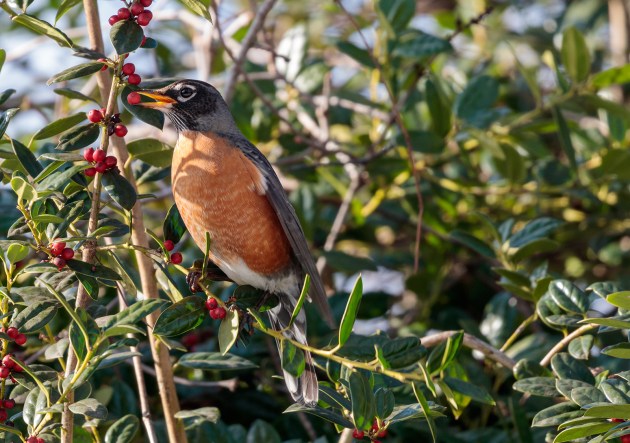
Which is one of the reasons many robins (primarily males) may stay through harsher winters instead of booking it to St. Petersburg: first access to the choicest nesting grounds. Breeding season is when robins also become more visible with mating displays, nest-building and a lot of time on the ground hunting for the tastiest worms. Until then, they’re all about the berries.
You Can Help Robins with Science from Your Own Backyard
Like many species, including other birds, scientists are starting to see some changes in robin behavior that is likely attributable to climate change. One study of American robins migrating to and from Canada’s boreal forest, showed that they’re beginning to journey south on average about 12 days earlier than in past years, or five days earlier per decade since 1994.
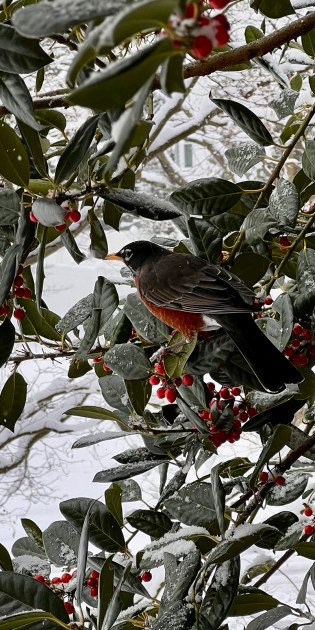
If you want to help scientists studying birds, there are several ways to contribute your observations (not just for robins, but for many of the species you can see outside your windows).
Journey North
You can submit your robin observations directly on the Journey North site (and check out their other migration-related citizen science projects). They also have 2025 maps tracking sightings so you can see where American robins (and other signs of spring) are being observed and follow along (and contribute to) the wanderings of Turdus migratorius.
Cornell Lab of Ornithology
The Cornell Lab has a number of different ways you can contribute to science for birds. Your sightings tracked on eBird (free) contribute to worldwide data for birding, science, and conservation. Want to know what birds are being seen in your neighborhood, eBird has a feature for that. If you’re new to birding, check out their genius birding ID app, Merlin.
You can also contribute to Project FeederWatch (requires subscription) by counting birds at your feeder from November through April. Your observations help scientists monitor changes in the abundance and distribution of birds, including the influence of changes in habitat, disease, and climate.
And mark your calendars for the 2025 Great Backyard Bird Count (February 14-17). Spend time in your favorite places watching birds—then report them to Cornell! It’s easy to participate, “in as little as 15 minutes notice the birds around you. Identify them, count them, and submit your counts to help scientists better understand and protect birds around the world. You can see the results from 2024 here.
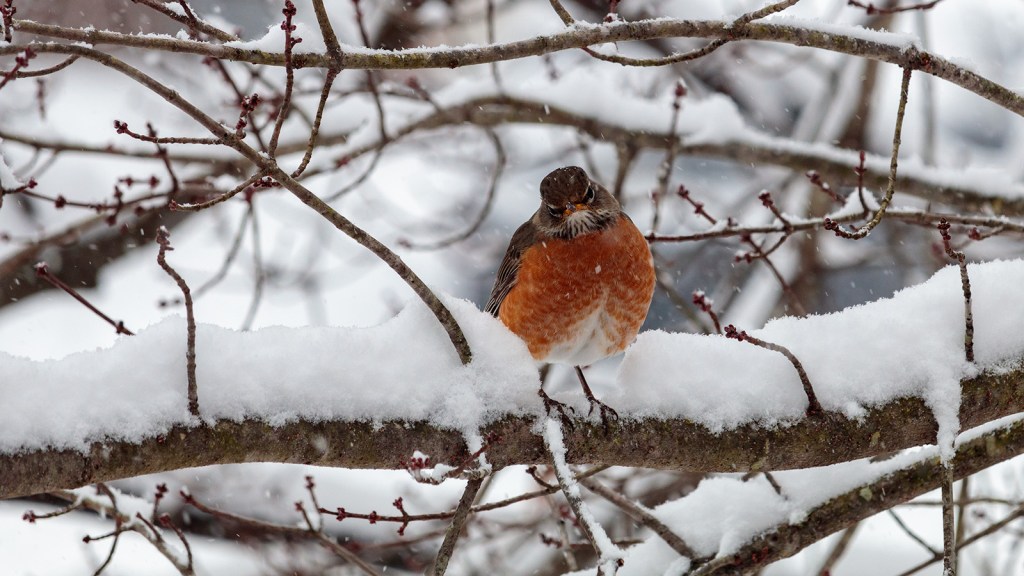



This week before the arctic front hit, I saw male robins in flocks all over Graham Texas! I kept saying I need to research this so finally I did. Its an amazing sight
We have had a flock of at least 50 in Belton Tx for about a week now.
We live in the Ft. Worth area of Texas. There are flocks of Robins all over the place. We have lived here for 11 years and I have never seen so many Robin’s here. They are eating tge berries in the trees and drinking water out of the swimming pool. They are beautiful and fun to watch.
I live just north of Dallas. We’ve have a nest in the Laurel bush by our front door. A pair of robins has been around most of the winter. Right now we’re having the coldest weather we’ve had in years (18 and below) with a blizzard like conditions ahead. I’m glad I read this article because I was worried about their survival. We have holly berries in our front yard. I hope they can eat them.
Hi Lisa, My husband and I live in Deephaven Mn near Lake Minnetonka. On thurs. Feb 11th we were sitting out on our south facing front porch getting some fresh air on a sunny day. We’ve been having about a week of below zero weather with -25 windchill. It’s 11am in the morning and suddenly we noticed lots of activity in a tree around 20 ft from us. we couldn’t believe our eyes, it was a flock (at least 6-10 ) of Robins. Lots with red bellies and some females. They kept flying over us and soon we realized that because the south facing roof was wet and dripping, they were drinking! of course we wondered where are they sleeping let alone eating. Now today is Sunday Feb 14th (Happy Valentines Day) and yes they are still here. I did some looking up on my computer and ended up with you. So I hope this helps you out in regards to migration and your project….your info was very informative. Minnesota -10 with a -25 windchill and it appears the males are staking out their territory and we are blessed with witnessing all of it!
Huge flocks are swarming our chinaberry trees. It’s Feb 2021 extreme cold, large males. We are in north Tx unusual cold, snow and very low temps predicted tonight. Its Valentine’s Day. Very interesting to watch.
thank you
Sunday, Feb. 14, 2021. It is snowing in North Texas this morning, and we are seeing literally hundreds of male robins flying from tree to tree or just sitting on the ground, feathers all poofed out, making them look huge! We have some yaupon holly trees around, and they are feeding on the berries in the trees and those that have fallen on the ground. It’s a beautiful sight, as we don’t see big flocks of robins in the area. I am 65 years old, and I have never seen this many robins in one place! Even my dog seems amazed.
I live in Scurry TX. We’ve had dozens of Robins the last few weeks. They are very curious. I was sitting quietly on my porch and one came within 5’ of me looking me over.
There is this very tall red berry Holley tree four doors from my house that red breast robins are feeding on.
I have noticed that there are 30-40 red breast robins that has perched in my red maple tree for the last two days. They even bathe and drink melting snow in the gutter. They are very fun to watch. There is one problem. They poop a lot, leaving berry filled poop under my tree in the snow and on my lawn and on my sidewalk. I have also noticed worm like substances everywhere. This is very interesting to me. 2/13/21
We have just noticed some in our yard this year. We keep food out for the Cardinals that come every year, but this is the first year I’ve seen the Robins.
I live in the Dallas area and I have never seen so many robins. I am wondering why.
Just yesterday the first time in my 61 yrs of like I saw a flock of Robins out my window. Upper Yoder Johnstown Pa. Matt B
We have thousands of robins in DFW area right now eating berries and pooping everywhere! Never seen so many here. 2-13-2021
We live in Plano, Texas, just north of Dallas. Yesterday, February 12, 2021, we had more than 50 very fat looking robins in our backyard. We have a pond with a waterfall running and they were drinking from it and also pecking at the ground. The temperature was cold, about 25 degrees and we are expecting snow on Monday due to the four storms circling the nation at the moment. They are back again today, although not as many. We’ve lived in this house since 1998 and this is the first year this has happened.
Lori Putchinski